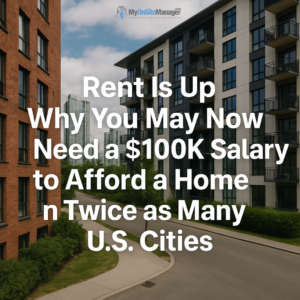If you’ve been browsing apartments and thinking, “Wasn’t this unit $400 cheaper just a year ago?”—you’re not alone. A recent Zillow analysis confirms what renters across the country have suspected for months: rents are on the rise, and affordability is slipping further out of reach for millions of Americans.
According to the report featured on Yahoo Finance, the number of U.S. cities where renters need to earn over $100,000 annually to avoid being rent-burdened has doubled since 2020. And that’s a startling wake-up call in a country where median household income is still well below that benchmark.
How Did We Get Here? A Look at the Driving Forces
Zillow’s findings point to a combination of economic and housing market trends converging to push rents higher across nearly every region in the U.S. Here are the main factors behind the rent surge:
Post-Pandemic Inflation
The COVID-19 pandemic disrupted supply chains and economic activity across the globe. As recovery kicked in, inflation followed—and with it, rising costs in nearly every sector, including housing. Rent prices didn’t just catch up—they leapfrogged.
Interest Rates and the “Locked-In” Effect
High interest rates have discouraged potential homebuyers from entering the market, keeping many stuck in the rental pool. This surge in demand, combined with a limited rental supply, has driven up prices. Additionally, many existing homeowners are staying put due to their locked-in low mortgage rates, further reducing housing turnover.
Migration Trends
People are moving to once-affordable secondary cities, driving up demand in those areas too. What used to be “safe zones” for budget renters are now seeing the same pressures that once defined big metros like New York or San Francisco.
Persistent Housing Shortages
The U.S. has long faced a housing shortfall, particularly in rental stock. Delays in construction and zoning restrictions have only worsened the problem. More people are competing for fewer available units.
Cities Feeling the Pinch the Most
Zillow’s data shows that twice as many cities now require six-figure incomes to afford rent compared to 2020. In some metros, even $100K doesn’t go as far as it used to:
-
San Jose, CA: Renters need an income of $145,000+ to afford a typical rental.
-
San Francisco, CA: Median rent requires around $139,000 annually to stay below the 30% income-to-rent threshold.
-
New York, NY: As always, rents continue to climb, especially in Manhattan.
Surprisingly, even traditionally more affordable areas like Austin, TX and Phoenix, AZ are starting to inch toward these same affordability levels due to population growth and increased housing demand.
Who’s Getting Hit the Hardest?
This rise in rent isn’t just a minor inconvenience—it’s altering life plans. The affordability crisis is impacting:
-
Young professionals trying to save for homeownership.
-
Families looking for stability in good school districts.
-
Retirees on fixed incomes.
-
Remote workers relocating to new cities, only to find their dollar doesn’t stretch as far.
As rents rise faster than wages, housing insecurity is becoming a middle-class issue, not just a concern for low-income earners.
What Can Renters Do?
While national economic forces are hard to fight, renters can still take steps to protect their finances:
Budget Strategically
Use the 30% rule as a guideline—rent should ideally not exceed 30% of your gross monthly income. If that’s no longer feasible, reassess spending or consider shared housing options.
Explore Alternative Markets
Suburban and exurban areas may still offer affordability. Working remotely? Consider metros with lower cost of living and growing rental stock.
Negotiate When Possible
Don’t underestimate the power of negotiation—especially if you’re a long-term tenant with a good payment history. Landlords may be willing to hold steady on rent to retain reliable renters.
Look Into Assistance Programs
Many cities offer housing grants, rent relief, or affordable housing lotteries. Explore local resources to find out what’s available.
Final Thoughts: A Shift That’s Here to Stay?
The data paints a clear picture: rental affordability is no longer a guarantee even for high-income earners. With economic uncertainty, high mortgage rates, and a slow-moving construction pipeline, renters may be navigating this high-cost landscape for the foreseeable future.
For landlords and property managers, understanding these trends is crucial—not just for pricing strategies, but for tenant retention and community-building efforts. For renters, staying informed and proactive is now more important than ever.
Source: Yahoo Finance – It’s Not Your Imagination: Rents Are Going Up, Zillow Says

